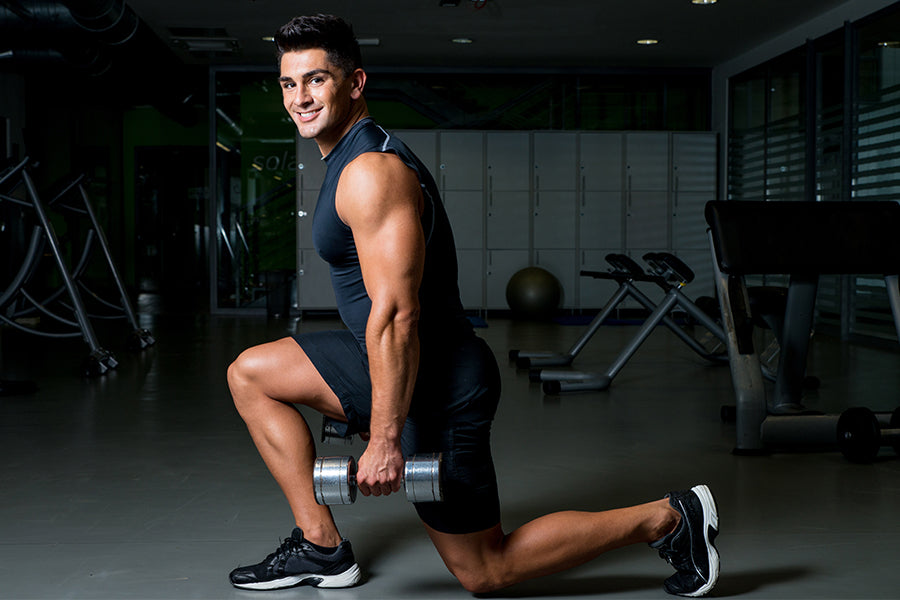Are you looking to get the most out of your glute workout? Lunges are one of the best exercises for building strong and toned muscles in your butt.
But it's not just about getting into a lunge position and hoping for the best; you can try many variations to get maximum results!
If you want to sculpt and strengthen your glutes, lunges are a fantastic exercise to incorporate into your fitness routine.
They are versatile lower-body movements targeting the glute muscles, quadriceps, hamstrings, and calves.
By incorporating various lunge variations into your workouts, you can maximize the results and accelerate your journey to glute greatness.
The Role of Lunges in Glute Development

Lunges are a compound exercise that primarily targets the glute muscles, including the gluteus maximus, medius, and minimus.
These muscles are responsible for hip extension, abduction, and external rotation, play a crucial role in pelvis stabilizing, and help generate power in lower body movements.
In addition to the glutes, lunges also engage the quadriceps, hamstrings, calves, and core muscles.
Strengthen Glutes
Lunges are highly effective for building strong and well-developed glute muscles.
You can enhance their strength, size, and overall definition by focusing on the glute activation during lunges.
Strong glutes contribute to an aesthetically pleasing physique, providing stability and power for various functional movements.
Enhance Lower Body Strength
Lunges engage multiple lower body muscles simultaneously, making them an excellent exercise for overall lower body strength development.
The quadriceps, hamstrings, and calves work during lunges, promoting balanced muscle development and functional strength.
Promote Stability and Balance
Lunges require stability and balance; you must maintain proper form while exercising.
The single-leg stance in lunges challenges your balance and activates stabilizing muscles around the ankles, knees, and hips.
Improved stability and balance gained through lunges can enhance your performance in other activities and reduce the risk of injuries.
Improves Flexibility
Lunges involve a deep stretch for the hip flexors of the rear leg.
This stretch can help alleviate tightness in the hip flexors, which can develop from sitting for extended periods or performing repetitive hip flexion activities.
Stretching the hip flexors during lunges improves flexibility and reduces the risk of imbalances and postural issues.
Improve Hip Mobility
Lunges require a significant range of motion in the hip joint, promoting better hip mobility.
By consistently performing lunges, you can increase the flexibility and mobility of your hips, allowing for more fluid movements and reducing the strain on other joints.
Enhance Range of Motion
Lunges result in a greater range of motion in the lower body muscles, including the glutes, hamstrings, and quadriceps.
Over time, this increased range of motion can translate to better athletic performance, improved functional movements, and a reduced risk of muscle imbalances and injuries.
Incorporating lunges into your fitness routine helps you develop stronger, more defined glute muscles.
This contributes to lower body strength, stability, balance, flexibility, and hip mobility.
By focusing on proper form and progressively challenging yourself, you can unlock the full potential of this exercise and reap its numerous benefits for glute development.
Related Article: Strong Glutes - 8-Week Booty Burner Workout
Step-By-Step Guide on Proper Lunge Form

Mastering proper form and technique is crucial for getting the most out of your lunges and maximizing their effectiveness.
Whether you're a beginner or an experienced fitness enthusiast, understanding the step-by-step guide for proper lunge form is essential.
By following the correct form, you can target the glutes, strengthen your lower body, and reduce the risk of injuries.
We will provide you with a detailed step-by-step breakdown of the lunge form, from the starting position to the execution of the exercise.
By mastering the fundamentals, you can confidently perform lunges and optimize your results in your quest for glute greatness.
How to Do It?
- Stand tall with your feet hip-width apart and your hands on your hips or sides.
- Keep your chest lifted and your shoulders back,
- Take a big step forward with your right foot, ensuring a comfortable stride length for a forward lunge.
- Take a step backward with your right foot for a reverse lunge.
- Lower your body by bending both knees once you've stepped forward or backward.
- Aim to create a 90-degree angle with your front leg, ensuring your knee is above your ankle. The back knee should be hovering just above the ground.
- Keep your torso upright and chest lifted; avoid leaning too far forward or backward.
- Your spine should remain neutral throughout the movement, with your head aligned with your spine.
- Push through the heel of your front foot from the lunge position to return to the starting position.
- Engage your glutes and leg muscles to powerfully push yourself back up.
- After completing the desired reps on one side, switch legs and lunge with the opposite leg leading.
Common Mistakes to Avoid During Lunges
The common mistakes to avoid during lunges include collapsing knees, forward-leaning, and inadequate stride length.
By understanding and rectifying these errors, you can perform lunges with proper form, effectively target the desired muscles, and safeguard yourself against unnecessary strain.
Let's delve into the common mistakes to avoid so you can lunge your way to glute greatness safely and efficiently.
Collapsing Knees
Keeping your knees in line with your toes during lunges is essential.
Avoid allowing your knees to collapse inward, as this can put excessive stress on the knee joint and increase the risk of injury.
Focus on pushing your knees out slightly to maintain proper alignment.
Forward Leaning
Leaning too far during lunges can shift the emphasis away from the glutes and onto the quadriceps.
Keep your torso upright, engage your core, and avoid leaning excessively forward or backward. This ensures proper activation of the glute muscles.
Inadequate Stride Length
Striking the right balance with your stride length is crucial.
Taking too small of a step can limit the range of motion and the activation of the glutes, while taking too large of a step can compromise stability and balance.
Find a comfortable stride length to achieve a 90-degree angle with your front leg.
Maintaining Alignment and Stability During Exercise
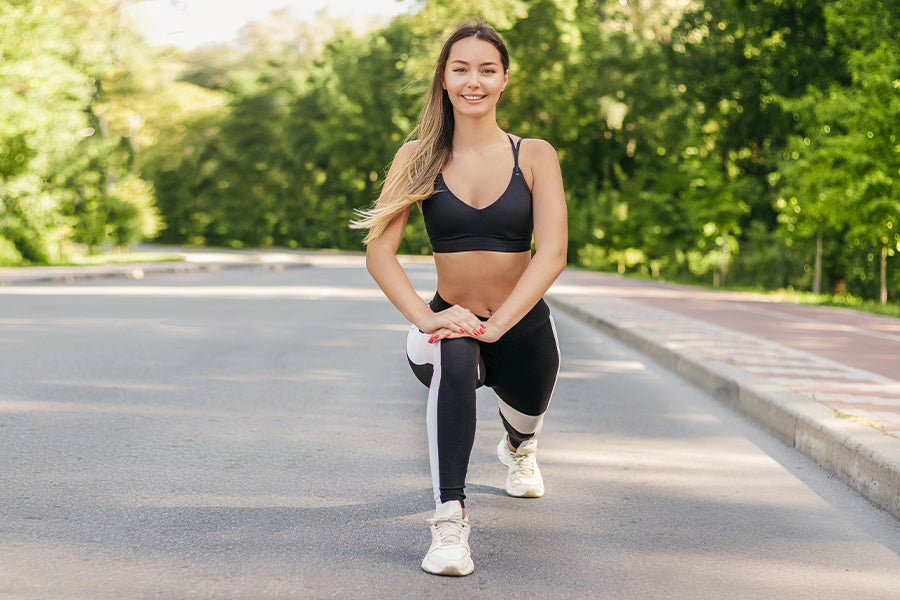
Maintaining proper alignment and stability during lunges is paramount for maximizing their effectiveness and preventing injuries.
When performed correctly, lunges target the glutes and lower body muscles, promoting strength, stability, and balance.
Focusing on alignment and stability ensures that the intended muscles are engaged and activated, leading to optimal results.
Muscle Engagement
Proper alignment during lunges ensures that the targeted muscles, particularly the glutes, are effectively engaged.
Maintaining stability and alignment allows you to maximize the activation of the desired muscle groups, leading to better results and muscle development.
Injury Prevention
Focusing on proper form and alignment reduces the risk of injury during lunges.
Incorrect alignment can place undue stress on joints, tendons, and ligaments, leading to strains, sprains, or other injuries.
Paying attention to stability and alignment promotes safe and effective exercise execution.
Targeted Muscle Development
Maintaining stability and alignment helps ensure that the intended muscles are being targeted during lunges.
It prevents compensatory movements that can shift the emphasis away from the glutes and onto other muscle groups.
Consistent focus on alignment allows for balanced muscle development and prevents muscle imbalances.
Improved Functional Movement
The core stability and balance developed through lunges can enhance your performance in various functional movements, such as walking, running, and jumping.
By following the step-by-step guide for proper lunge form and avoiding common mistakes, you can optimize the benefits of lunges.
Maintaining alignment and stability ensures that you target the intended muscles, minimize the risk of injuries, and enhance overall movement quality.
Take the time to master the correct form and technique for lunges, and you'll be well on your way to glute greatness and improving lower body strength.
Forward Lunge Variations
Forward lunges are a staple exercise for targeting the glutes and building lower body strength.
However, several variations of the forward lunge can take your workout to the next level.
Each variation adds a unique element, providing different challenges and targeting specific muscles within the lower body.
Incorporating these forward lunge variations into your routine allows you to add variety, increase intensity, and enhance your overall glute development.
This guide will explore three popular forward lunge variations: walking lunges, reverse lunges, and elevated front foot lunges.
You can elevate your lunge training and achieve maximum results by mastering and incorporating these variations into your workouts.
Walking Lunges
Walking DB Lunges [glute focused] • 3 sets x16 steps
— Miranda Cohen (@mirandacohenfit) February 7, 2023
Notice how I’m keeping my knee behind my toes with a more vertical shin placement and I’m trying to place my body weight into my heel each step. pic.twitter.com/wOh3OmWSAg
Walking lunges are a dynamic variation of the forward lunge that adds an element of movement, making them an excellent choice for targeting the glutes and building lower body strength.
This variation engages the glute muscles and challenges your balance and coordination.
Step-by-Step Guide
- Begin in a standing position with your feet hip-width apart and your hands on your hips or by your sides.
- Step forward with your right foot into a forward lunge, lowering your body until your right thigh is parallel to the ground and your right knee is directly above your ankle.
- Push off your right foot and bring your left foot forward into the next lunge.
- Continue alternating legs and lunging forward, maintaining proper form and alignment.
- Keep a steady pace and ensure that each lunge is controlled and stable.
- Aim for a desired number of repetitions or distance, depending on your fitness level and goals.
Reverse Lunges
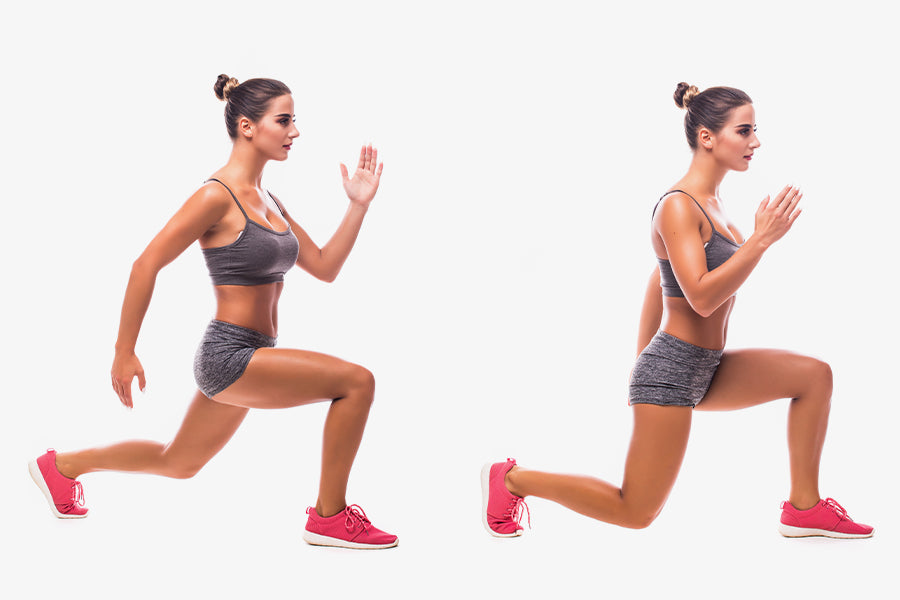
Reverse lunges are a variation of the forward lunge that places a slightly different emphasis on the muscles of the lower body.
Reverse lunges uniquely engage the glutes, quadriceps, and hamstrings by stepping backward instead of forward.
They also offer stability and can be an excellent option for those who find forward lunges uncomfortable on their knees or joints.
Step-by-Step Guide
- Begin in a standing position with your feet hip-width apart and your hands on your hips or by your sides.
- Step backward with your right foot, landing on the ball of your foot and bending both knees to lower your body.
- Lower yourself until your left thigh is parallel to the ground and your left knee is directly above your ankle.
- Push off your right foot and return to the starting position.
- Repeat the movement with the opposite leg, stepping back and alternating legs with each repetition.
- Maintain proper form and alignment throughout the exercise, focusing on stability and controlled movement.
- Perform the desired number of repetitions, ensuring a challenging yet manageable workload.
Elevated Front Foot Lunges
Elevated front-foot lunges add an extra challenge to the traditional forward lunge by elevating the front foot on a step or platform.
This variation increases the range of motion, targeting glute muscles, quadriceps, and hamstrings.
Elevated front-foot lunges are an excellent option for those looking to progress their lunge training and take their glute development to new heights.
Step-by-Step Guide
- Stand in front of a step or platform with your feet hip-width apart and your hands on your hips or sides.
- Place the top of your right foot on the step, elevating it a few inches off the ground.
- Step forward with your left foot into a lunge position, lowering your body until your left thigh is parallel to the ground and your left knee is directly above your ankle.
- Push off your left foot and return to the starting position.
- Repeat the movement, this time stepping forward with your right foot and lowering into a lunge.
- Continue alternating legs and performing the elevated front foot lunges with control and stability.
- Focus on maintaining proper form and alignment, engaging the glutes, and ensuring a challenging yet manageable workload.
Side Lunge Variations
Side lunges are a significant variation of lunges that target the glutes' inner and outer thighs and improve overall lower body strength and stability.
However, you can incorporate several side lunge variations and enjoy the benefits.
This category will explore three popular side lunge variations: lateral lunges, curtsy lunges, and sliding side lunges.
By mastering these variations and integrating them into your fitness regimen.
You can enhance your lateral movement, strengthen specific muscle groups, and achieve a well-rounded lower-body workout.
Let's dive into these side lunge variations and discover how they can take your lunges to the next level.
Lateral Lunges
Up next is
— Eric 🏋🏾♂️ 🥘 😴 (@KoachEric) May 25, 2023
3 x 6 on lateral lunges
3x 8 SDL pic.twitter.com/QrLxsPLP2W
Lateral lunges, or side lunges, are an excellent variation of lunges that target the glutes, inner and outer thighs, and adductors.
This movement emphasizes lateral movement and challenges the muscles in a different plane of motion.
Lateral lunges are particularly beneficial for improving hip mobility, strengthening the inner and outer thigh muscles, and enhancing overall lower body stability.
Step-by-Step Guide
- Begin by standing tall with your feet hip-width apart and your hands on your hips or sides.
- Take a wide step to the right side, keeping your toes pointed forward and your feet parallel.
- Shift your weight to the right foot and bend your right knee, pushing your hips back and lowering your body toward the right side.
- Keep your left leg straight as you lower, feeling a stretch in your inner thigh.
- Push through your right foot and return to the starting position, engaging your glutes and inner thigh
- Repeat the movement on the left side, stepping wide to the left and bending the left knee.
- Alternate between right and left lateral lunges, maintaining proper form and alignment throughout the exercise.
- Aim for a desired number of repetitions or times, depending on your fitness level and goals.
Curtsy Lunges
Curtsy lunges are a variation that targets the glutes, inner thighs, and outer hips while also engaging the quadriceps and hamstrings.
This lunge variation adds a cross-behind movement, mimicking the curtsy gesture. Curtsy lunges uniquely challenge the lower body muscles and promote balance and stability.
Step-by-Step Guide
- Stand tall with your feet hip-width apart and your hands on your hips or sides.
- Step your right foot diagonally behind your left leg, crossing it behind you.
- Bend both knees, lowering your body into a lunge position, with your right knee hovering just above the ground.
- Keep your chest lifted, engage your core, and maintain a neutral spine throughout the movement.
- Push through your left foot and return to the starting position.
- Repeat the movement, crossing your left foot behind your right leg.
- Continue alternating between right and left curtsy lunges, focusing on proper form and alignment.
- Perform the desired number of repetitions, keeping control of the movement and engaging the targeted muscles.
Sliding Side Lunges
Sliding side lunges add an extra challenge to the traditional side lunge by incorporating a sliding or gliding motion.
This variation requires a gliding disk or towel placed under one foot to facilitate sliding.
Sliding side lunges engage the glutes and inner and outer thighs, challenging your stability and control.
Step-by-Step Guide
- Stand with your feet hip-width apart, placing a gliding disk or a towel under your right foot.
- Shift your weight to your left foot and slide your right foot out to the side, keeping it straight.
- Bend your left knee, lowering your body into a side lunge position, with your right foot sliding away from the midline.
- Push through your left foot and slide your right foot back to the starting position.
- Repeat the movement, sliding your left foot to the side and bending your right knee.
- Alternate between right and left sliding side lunges, focusing on proper form and alignment.
- Keep your core engaged and maintain stability throughout the movement.
- Perform the desired number of repetitions, challenging yourself while maintaining control and stability.
Split Lunge Variations
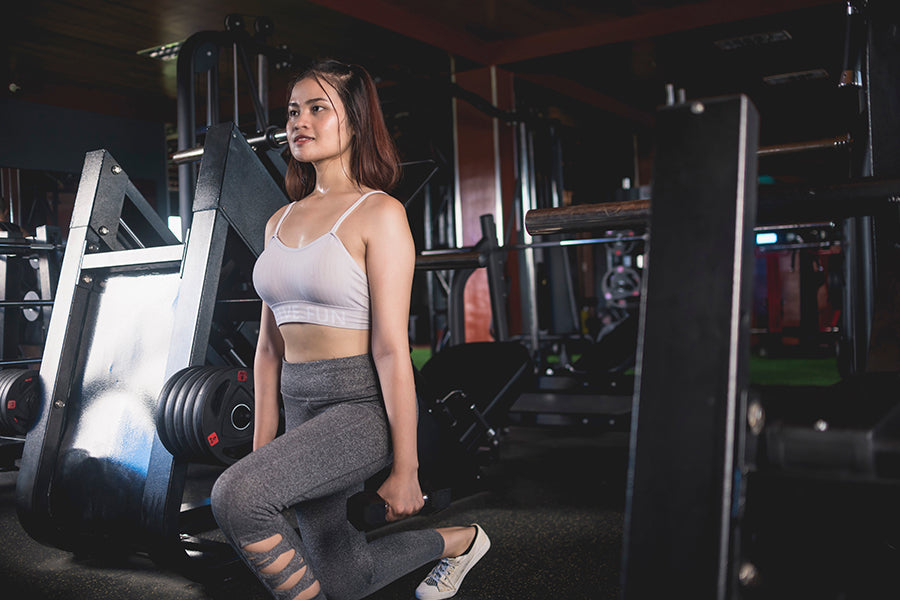
Split lunge variations offer a dynamic and effective way to target the lower body muscles, improve strength, and enhance overall stability.
By incorporating these into your workout routine, you can add diversity and challenge to your lunges, maximizing the benefits for your glutes, quads, and hamstrings.
This category will explore three popular split lunge variations: Bulgarian split squats, walking lunges with overhead weight, and jumping lunges.
Each variation provides unique advantages, from increased muscle activation to improved power and coordination.
Whether you want to build strength, add intensity, or enhance explosive power, these split lunge variations have covered you.
Let's dive in and discover how these variations can take your lunges to new heights.
Bulgarian Split Squats
Them Bulgarian split squats are not for the weak. pic.twitter.com/3NktDoH6Sv
— 3Stacks (@DarrelSwavey) June 1, 2023
Bulgarian split squats are a challenging and effective variation of the split lunge that primarily targets the glutes, quads, and hamstrings.
This exercise is performed with one foot elevated behind you, emphasizing the front leg and intensifying the workout.
Bulgarian split squats are highly beneficial for building lower body strength, enhancing balance, and improving stability.
Step-by-Step Guide
- Begin by placing a bench or step behind you.
- Stand tall with your feet hip-width apart, and take a step forward with one foot, positioning it a few feet in front of the bench.
- Lift your back foot and place the top of your foot onto the bench, ensuring your front foot is far enough forward for proper balance.
- Engage your core, keep your torso upright, and maintain a neutral spine throughout the movement.
- Bend your front knee and lower your body toward the ground, aiming for a 90-degree angle in both knees.
- Push through your front heel and return to the starting position, maintaining control and stability.
- Repeat the movement for the desired number of repetitions on one leg before switching to the other leg.
Walking Lunges With Overhead Weight
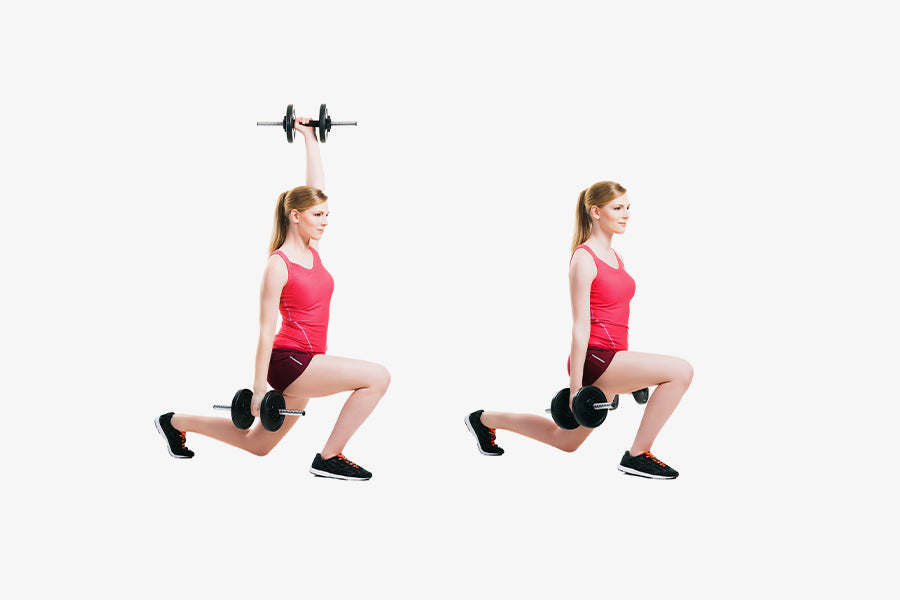
Walking lunges with overhead weight are a dynamic and challenging variation that combines the benefits of lunges with upper-body strength training.
Adding an overhead weight, such as an adjustable dumbbell or kettlebell, engages the core, shoulders, and arms while targeting the glutes, quads, and hamstrings.
This variation enhances overall body strength, coordination, and stability.
Working out with DMoose adjustable dumbbell set is an excellent investment for your home gym, offering many features.
With this set, you can engage in a wide range of exercises, targeting various muscle groups and achieving a comprehensive workout routine.
Built with durability, these dumbbells are sturdy and user-friendly, ensuring long-lasting performance and hassle-free adjustments.
Step-by-Step Guide
- Begin by holding a dumbbell or kettlebell in both hands at shoulder height, with your palms facing inward.
- Step forward with your right foot, lowering your body into a lunge position with a 90-degree angle in both knees.
- As you step forward, press the weight overhead, fully extending your arms.
- Push through your front heel and bring your back foot forward, stepping into the next lunge.
- Repeat the movement, alternating legs and walking forward while maintaining proper form and control.
- Focus on keeping your core engaged, shoulders stabilized, and maintaining a steady rhythm throughout the exercise.
- Perform the desired number of walking lunges with overhead weight, challenging yourself while maintaining proper form.
Jumping Lunges
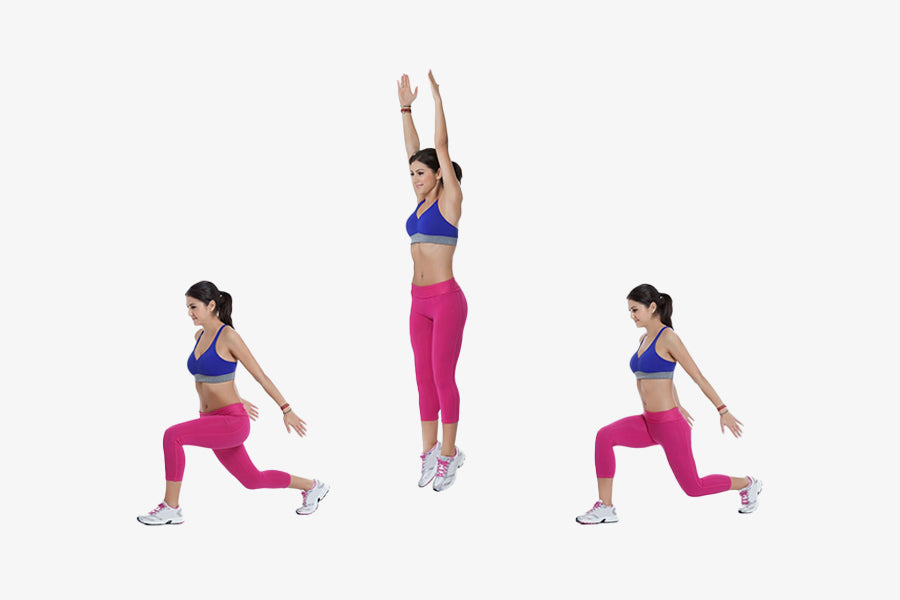
Jumping lunges are an advanced plyometric variation that adds an explosive element to traditional lunges, targeting the glutes, quads, and calves.
This exercise improves power, cardiovascular endurance, and lower body strength.
Jumping lunges require coordination and control, making them suitable for those who have mastered the basic lunge technique.
Step-by-Step Guide
- Begin in a lunge position with your right foot forward and your left foot behind, ensuring both knees are bent at a 90-degree angle.
- Engage your core, maintain an upright posture, and keep your gaze forward.
- Push explosively off the ground, jumping into the air and simultaneously switching the positions of your legs mid-air.
- Land with your left foot forward and your right foot behind you, immediately bending your knees into a lunge position.
- Repeat the movement, alternating legs and jumping explosively with each repetition.
- Focus on maintaining proper form and alignment throughout the exercise, landing softly and absorbing the impact through your legs.
- Perform the desired number of jumping lunges, challenging yourself while maintaining control and stability.
Other Lunge Variations
In addition to the classic forward, side, and split lunges, a vast array of other lunge variations can take your lower body workout to the next level.
These variations offer unique challenges, target different muscle groups, and provide opportunities for increased strength, stability, and mobility.
Incorporating these other lunge variations into your routine allows you to add variety and intensity and maximize your results.
Whether you aim to enhance glute activation, improve coordination, or increase power, these variations have something to offer everyone.
Get ready to discover a new dimension of lunges as we delve into the world of other lunge variations.
Reverse Lunge With Knee Drive
The reverse lunge with knee drive is a challenging variation that targets the glutes, hamstrings, quads, and core muscles.
Adding a knee drive at the top of the movement further engages the hip flexors and challenges your balance and stability.
This variation is ideal for improving lower body strength, enhancing coordination, and adding an explosive element to your lunges.
Step-by-Step Guide
- Start by standing tall with your feet hip-width apart and your hands on your hips or sides.
- Step backward with your right foot, lowering your body into a reverse lunge position with both knees at 90-degree angles.
- Push through your left heel and bring your right foot forward, lifting your knee toward your chest.
- Balance on your left leg as you drive your right knee up, engaging your core muscles.
- Lower your right foot back to the ground and step back into the next reverse lunge.
- Repeat the movement on the opposite leg, stepping back with the left foot and driving the left knee up.
- Continue alternating legs and perform the reverse lunge with knee drive for the desired repetitions, focusing on proper form and stability.
Deficit Lunges
THIS IS THE SUPERSET YOU NEED TO DO ON YOUR GLUTE DAY.
— nataleebfitness (@nataleebfitness) September 28, 2022
Dumbbell steps up // Reverse deficit lunges
The step up motion targets your ‘under glutes’ to lift them and the deficit lunges keep your glutes under tension for longer! pic.twitter.com/UjkRxsRBEB
Deficit lunges involve performing lunges with one foot on a slightly elevated surface, such as a step or platform.
This variation increases the range of motion and adds a more significant challenge to the lower body muscles.
Deficit lunges primarily target the glutes, quads, and hamstrings while also engaging the core and improving balance and stability.
Step-by-Step Guide
- Stand in front of a step or platform with your feet hip-width apart.
- Place the top of your right foot on the step, elevating it a few inches off the ground.
- Step forward with your left foot, lowering your body into a lunge position with both knees at 90-degree angles.
- Push through your left heel and return to the starting position.
- Repeat the movement, stepping forward with your right foot and lowering into a lunge.
- Continue alternating legs and performing the deficit lunges, maintaining proper form and alignment.
- Focus on stability and control throughout the movement, engaging the targeted muscles.
- Perform the desired number of repetitions, adjusting the height of the deficit based on your fitness level and comfort.
Weighted Lunges
Weighted lunges involve adding external resistance, such as dumbbells, kettlebell, or a barbell, to increase the intensity and challenge of the exercise.
This variation allows for greater muscle activation and development, primarily targeting the glutes.
Weighted lunges are excellent for building strength, promoting muscle growth, and advancing your lunge training.
The DMoose kettlebell can build and tone your muscles, promoting strength and muscular development.
Furthermore, working out with a kettlebell improves your balance and coordination, helping you maintain stability during movements.
Step-by-Step Guide
- Begin by holding a dumbbell in each hand or placing a barbell across your upper back, resting on your shoulders.
- Stand tall with your feet hip-width apart and your hands on your hips or by your sides.
- Step forward with your right foot, lowering your body into a lunge position with both knees at 90-degree angles.
- Push through your front heel and return to the starting position.
- Repeat the movement, stepping forward with your left foot and lowering into a lunge.
- Continue alternating legs and performing the weighted lunges, maintaining proper form and alignment.
- Focus on engaging the targeted muscles and controlling the weights throughout the movement.
- Perform the desired number of repetitions, selecting a weight that challenges you while allowing for proper form and stability.
Related Article: The Ultimate Inner Thigh Workout: 10 Best Inner Thigh Exercises for Women
Tips for Maximizing Results
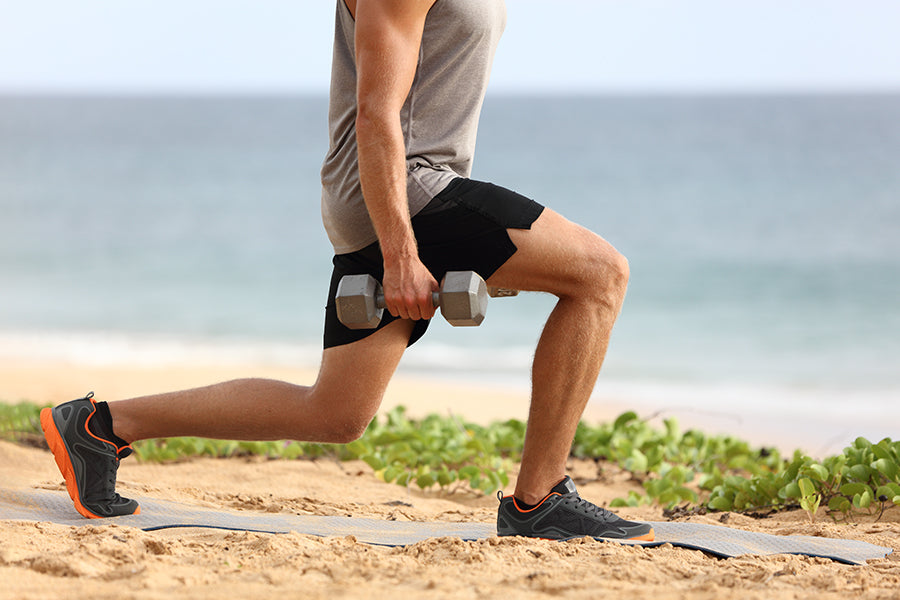
You must implement specific strategies into your training routine to maximize results and achieve optimal glute development through lunges.
These tips will help you maximize the effectiveness of your lunges, prevent injuries, and continue progressing toward your goals.
By focusing on proper warm-up and stretching, incorporating progressive overload, and listening to your body's needs.
You can ensure that your lunges yield the best possible results. Let's explore these tips in detail.
Proper Warm-Up and Stretching Before Lunges
Before diving into lunges, it's crucial to dedicate time to a proper warm-up and stretching routine.
Engaging in dynamic movements, such as leg swings, hip circles, or light cardio exercises, will increase blood flow and warm up the muscles.
Additionally, stretches target the hip flexors, quadriceps, and glutes to enhance flexibility and mobility for a greater range of motion during the lunge movement.
Investing a few minutes in an adequate warm-up and stretching routine will reduce the risk of injury and optimize your performance during lunges.
Incorporating Progressive Overload For Continued Glute Development
To continue challenging your glutes and promoting growth and strength gains, it's crucial to incorporate progressive overload into your lunge training.
Progressive overload gradually increases your workouts' intensity, resistance, or volume.
This can be achieved by adding weights, increasing repetitions or sets, or progressing to more challenging lunge variations.
Listening to Your Body to Adjust the Intensity & Variations as Per Your Fitness Needs
Each individual has unique fitness levels and capabilities. It's essential to listen to your body and adjust the intensity and variations of lunges accordingly.
Pushing yourself too hard without proper rest or recovery can lead to burnout or injuries. On the other hand, not challenging yourself enough may limit your progress.
Pay attention to how your body feels during and after lunges, and make necessary adjustments.
This could involve modifying the range of motion, selecting appropriate weights, or choosing variations that suit your current fitness level.
You can optimize your lunges and ensure they align with your fitness journey by tuning in to your body's cues and modifying them as needed.
Key Takeaways
Lunges are a powerhouse exercise for glute development, offering numerous benefits for strength, stability, balance, flexibility, and hip mobility.
Incorporating lunge variations into your training routine is highly recommended, whether with added weights, increased range of motion, or even plyometric movements.
However, you must obtain the proper form and the right equipment plus accessories to help you do the workout in the right way without causing injuries.
Joining a gym is not necessary, as you can have some home gym equipment to do the exercise, such as barbells, dumbbells, kettlebells, etc.
DMoose helps you buy perfect portable tools you can use at home, keep in your vehicles, or take along anywhere.
Before you leave this page, don’t forget to check their latest collection.








